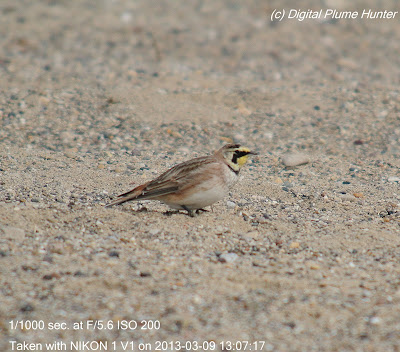Lapland Longspur is a songbird of the arctic tundra found in North America as well as Eurasia. Its global population is thought to number 150 million and, in certain areas, it is not uncommon to see wintering flocks in the millions. At Lake St. Clair Metropark in Michigan a small flock of about a half-dozen were observed feeding in a mixed flock with snow buntings and horned lark.
Taxonomically, this species were formerly placed with new world sparrows (Emberizidae) but now finds itself in its own family of longspurs and snow buntings (calcariidae) -- a family of just 6 species: 2 buntings (Snow and McKay's) and 4 longspurs (Lapland, McCown's, Smith's, and Chestnut-collared).
Lapland Longspur in full breeding plumage has a black face, forehead and bib; and, a chestnut nape and brow outlined in white. The male shown above shows signs of coming into alternate plumage.
The lapland longspur eats all manner of seeds in the winter but survives largely on insects in the summer.
The photo above shows the long hind claw, or long spur, of its feet -- a feature that gave rise to its common name.
Lapland Longspur bathing.
The longspur's close relative, the snow bunting, were also found in their company. These attractive birds with pure ivory plumage on the breast and undersides are always a pleasure to observe.
In breeding plumage, the male becomes even more dazzling -- completely white except for a black back.
Unlike the Longspur, the Snow Bunting's population trends are worrying -- the species has suffered a 60% decline in North America over the last few decades. However, its global population is still large and hence it is officially classified as "Least Concern".
Finally, some signs of spring: An American Robin -- its beauty oft overlooked because of its abundance.
.... Song Sparrows were singing....
And, red-winged blackbirds [not shown] were trilling and displaying.
Before Spring migrants arrive in full force, it is still time to enjoy our wintering guests such as the snow buntings and longspurs before they become a distant memory to our warblers, shorebirds, and flycatchers.















1 comment:
Another rewarding report, Hemant. It's my hope to see the Snow Bunting for the first time in the wild at Merritt Island NWR in 2014. A great find of yours was made with the banded Song Sparrow. Hopefully the bander can be notified. I still don't know the fate of the Horned Lark observed at Fort De Soto Park this past June as a reply was never received from my inquiry of the bird's condition.
Post a Comment